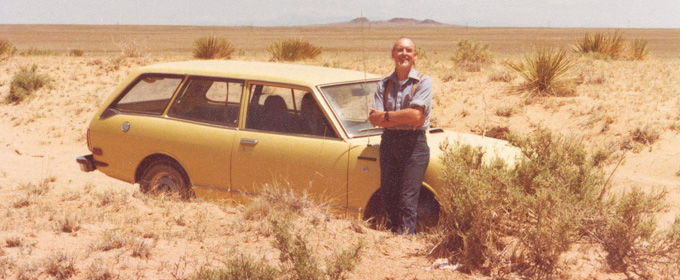How to save a life: Preserving the physics of John Linsley

This photo of John Linsley is from the Fermilab Archive. It was taken in 1977 and most likey depicts Linsley near the Volcano Ranch experiment in New Mexico, where Linsley observed the first ultra-high energy cosmic ray.
On his death bed, cosmic-ray pioneer John Linsley made it clear that he wanted to leave a legacy.
"He kept repeating that he didn't want his stuff thrown into a dumpster," said Linsley's daughter in law Joanna Quargnali-Linsley, who took care of him his last six weeks. "But Linsley never liked institutions, so there was no obvious place to donate his papers."
After Linsley's death in September 2002, Quargnali-Linsley spent the next several months looking for an organization that could preserve Linsley's lifework. John Peoples, Fermilab's former director, and Ruth Pordes answered the call.
"Linsley represents the pre-history of the Pierre Auger Observatory, and part of Fermilab's focus is the cosmic frontier. It made sense for us to take on his collection," commented Adrienne Kolb, who is the PI on this project.
In late 2004, twenty six boxes filled with binders, note books and files documenting Linsley's colorful life arrive at Fermilab's doorstep.
For several years, Linsley's collection sat in storage. But when astrophysicist Eun-Joo 'Sein' Ahn arrived at Fermilab and learned about its existence, she spearheaded a project to bring the collection out of storage and into the public eye.
"John Linsley is a big name in cosmic ray research. He was a pioneer of large-scale extensive experiments and in the early 1960's discovered the highest energy cosmic rays," Ahn said.
Ahn and Kolb applied for a grant from the American Institute of Physics which approved $10,000 for Fermilab to organize and document the collection. Today, professional archivist Valerie Higgins is recording, sorting, and creating a searchable directory for the collection.
"Archive project like these are important because you can watch how theories and ideas developed," Higgins said. "I'm making an on online finding aid for this collection that will let anyone who is interested in Linsley's life easily search through the documents we have."
This project is expected to be completed in the next six months and will help memorialize Linsley's contribution to cosmic ray research.






